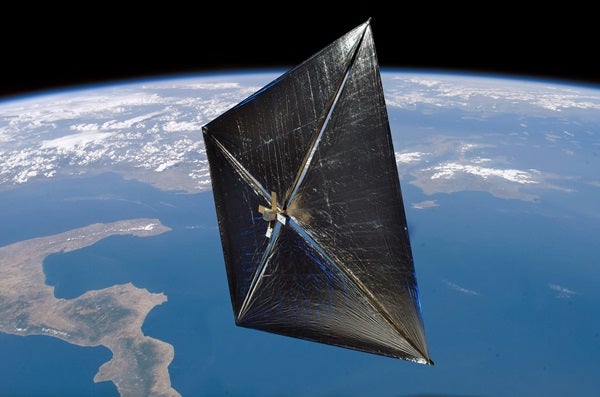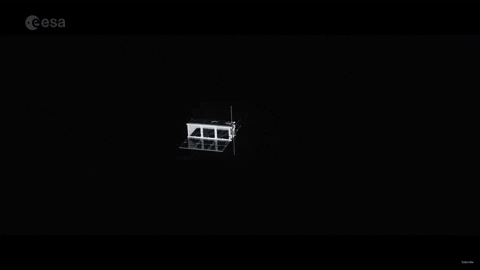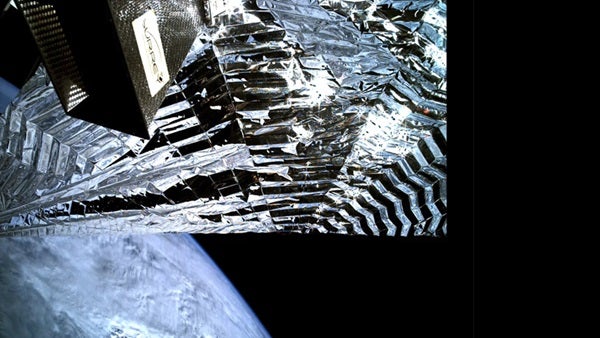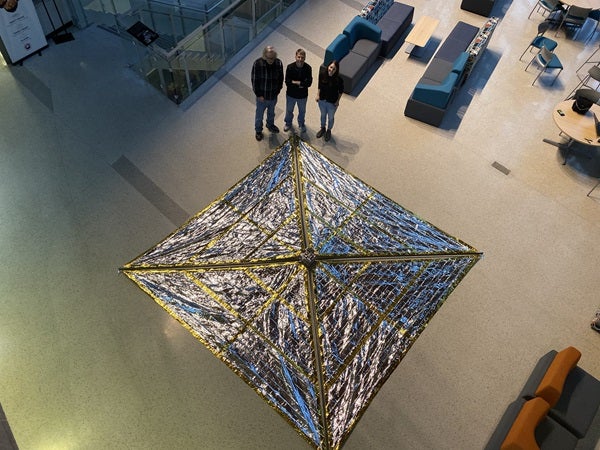Compared with environmental concerns like our rapidly warming climate and the proliferation of microplastics, the accumulation of debris in low Earth orbit may seem like a distant issue.
But the current boom in satellite launches could potentially convert the space around Earth into a low-gravity junkyard. If left unchecked, this growth in defunct spacecraft and debris from collisions could eliminate the use of satellite constellations, sending society back to landlines and paper maps.
As the space industry grapples with this impending threat, drag sails have emerged as a technology that could help slow the growth of cascading collision fields by using atmospheric friction to quickly deorbit new spacecraft after missions end. Since 2011, when the concept was demonstrated by a NASA test nanosatellite, more teams from the U.S., Japan, Canada, Europe, and the U.K. have all deployed and operated experimental drag sails.
Now, the pace of tests is accelerating. In the past six months, groups at Purdue University and the University of Alabama (UA) each launched experimental drag sails, but the commercial rockets carrying their host satellites failed to reach orbit. On Sept. 2, 2021, the rocket carrying Purdue’s satellite — the first-ever test launch by Firefly Aerospace — exploded shortly after launch. And on Feb. 10, 2022, UA’s craft was lost when a rocket from the startup Astra tumbled out of control.
Despite the setbacks, drag sail proponents say the technology is scalable and cost-effective, and could at least buy enough time to develop spacecraft that can actively sweep debris out of orbit.
“Long term, I think drag sails are a great solution that could be integrated into almost anything going into low Earth orbit of reasonable size — just a very small plug-and-play capsule,” says Abby Feeder, Project Manager for the BAMA-1 drag sail mission at Alabama. “Right now we have certain standards for a 25-year end-of-life plan, but there’s not necessarily ways to enforce that, whereas if every satellite that went up into space was equipped with a drag sail or something similar, it could take itself out of orbit at the end of life. I think it could become quite common.”
A space junk tipping point
Although deep-space exploration missions like the Apollo program and Mars rovers may get the most public attention, the vast majority of what humans send into space ends up in low Earth orbit (LEO), circling the planet at up to 4.8 miles per second (7.8 kilometers per second) somewhere between 186 and 1,240 miles (300 and 2000 kilometers) above our heads. This includes satellites for communication, geopositioning, and remote sensing; our space stations and telescopes; and all the apparatus associated with launching these spacecraft.
At those altitudes, spacecraft remain within the tenuous upper fringes of the atmosphere, in the thermosphere and exosphere. Most of them stay there after missions end, drifting with no control until the compounding effects of gravity and atmospheric friction drag them toward reentry and immolation.
Depending on their altitude, this can take years or even decades. According to ESA’s Space Debris Office, of the roughly 12,900 satellites that have been placed in orbit since the Space Age began, over 60 percent are still there — and over 30 percent of those are no longer functioning. The longer they take to deorbit, the larger the likelihood they will collide with other defunct satellites or pieces of debris.
In a 1978 paper, NASA astrophysicist Donald Kessler described the worst-case scenario, where space pollution in LEO increases to such a degree that “satellite collisions would produce orbiting fragments, each of which would increase the probability of further collisions,” forming a belt of debris around Earth. In a scenario now known as the Kessler syndrome, this cloud of colliding detritus could engulf and destroy existing satellite constellations, preventing us from placing satellites in LEO for centuries.
By 2005, NASA researchers found the problem had already reached a critical threshold: Even completely halting all future launches would fail to prevent the growth of space debris, as collisions of existing satellites would generate new fragments faster than atmospheric drag removes them.
Things haven’t improved since then. SpaceX has regulatory approval to launch up to 12,000 new satellites for its Starlink internet service and has already followed up with a request to launch 30,000 more. Three recent events — the intentional destruction of a Chinese weather satellite in 2007, the collision between a defunct Russian and commercial US satellite in 2009, and the Russian destruction of a retired spy satellite in 2021 — have added a combined estimated 6,500 pieces of debris to LEO, dramatically increasing the possibility of future collisions. And a 2021 audit by the NASA Inspector General found that “orbital debris has already reached critical mass,” concluding that effectively addressing the issue would require “global mitigation and strategic remediation efforts.”
Remediation — the attempt to actively remove existing space debris — unfortunately remains prohibitively expensive and complex.
Taking a drag
Of the many competing concepts for mitigating space junk, drag sails are one of the most intuitive. They are synthetic sails deployed from a spacecraft to create additional drag when its mission ends, slowing and deorbiting the craft sooner than would otherwise be possible.
“Drag sails work by using the slightest, thinnest layers of atmosphere, existing at the higher levels, as a mechanism that will hit the sail and slow down the spacecraft,” says Rohan Sood, director of UA’s Astrodynamics and Space Research Laboratory. “We are deploying a sail that is perpendicular to the direction of the spacecraft’s motion, which slows down and deorbits the craft.”
One of the first craft to demonstrate the concept was NASA’s Nanosail-D2, a water bottle-sized nanosatellite that deployed a 108-square-foot (10 square meters) sail in 2011. Instead of taking an estimated 50 years to fall to Earth from its 400-mile-high (650 kilometers) orbit, the satellite reentered the atmosphere and burned up in less than one year.
Because drag sails work passively, using nothing but atmospheric resistance, drag sails present a unique means of preventing future space junk. Competing deorbiting technologies like electric propulsion — used by SpaceX in their Starlink constellation — require a power source onboard the spacecraft, which could be vulnerable to complications.
“If the spacecraft works well all the way through the mission, that’s fine, but if that host spacecraft dies or loses functionality, that electric propulsion system isn’t going to be effective in deorbiting,” says David Spencer, a Mission Systems Manager with NASA’s Jet Propulsion Laboratory and director of Purdue’s Space Flight Projects Laboratory. “That’s where drag sails provide a more fail-safe approach, in our opinion.” (For its part, SpaceX says it doesn’t fly Starlink satellites any higher than 370 miles [600 km], which reduces the time that inoperable craft deorbit to five or six years.)
The concept is intuitive enough in theory, but the key challenge is designing the deployment system, Spencer says. “We’ve got these long booms that are stowed in a very tight area, we’ve got large sail materials that have to be crammed in these small storage compartments for years, and when that deployment command comes, it all has to work properly.”
Even successfully deployed drag sails may encounter problems as orbits decay and spacecraft pass into lower, denser regions of the atmosphere. When this happens, drag sails must remain perpendicular to the motion of the craft to sustain effect. “If the sail starts to tumble and is no longer perpendicular, the drag effect decreases, and if it is parallel, can be zero,” Sood says. “So, the challenge is also controlling the attitude of the sail.”
Spacecraft typically use active methods of attitude control, which require a source of power — like thrusters or reaction wheels. But a drag sail for a defunct satellite wouldn’t be able to count on having power.
Spencer’s team turned to badminton for inspiration. Their Spinnaker-1 sail model takes the shape of a pyramid once it’s deployed. “That pyramid acts like a shuttlecock would,” says Spencer, which automatically turns the vehicle to the orientation that provides maximum drag.
Scaling up
Despite possible obstacles to deployment and attitude control, drag sails remain one of the cheaper new technologies for quickly deorbiting satellites, and in the booming space industry, money talks. “Somebody needs to pay to make sure these vehicles are going to deorbit,” says Spencer, who founded the company Vestigo Aerospace to commercialize drag sails. Active debris removal could cost hundreds of millions of dollars, he argues, while one of his drag sails will only cost tens of thousands.
Vestigo is developing two models of sail: One with an area just over 19 square feet (1.77 square meters) for small CubeSats, and a nearly-200-square-foot (18 square meters) model that could deorbit small satellites and the upper stages of launch vehicles weighing up to 2,200 pounds (1,000 kilograms).
This scalability is a key advantage of the new technology. Adaptable to nearly the full range of active spacecraft, drag sails could help ward off full-scale Kessler syndrome until active debris removal becomes economically feasible.
Vestigo will conclude a Small Business Innovation Research grant from the National Science Foundation in June 2022, but has applied for a one-year extension to develop the commercial manufacturing process. They expect to start taking orders in the second half of 2022 and delivering drag sails to customers by 2023.
The teams at Purdue and Alabama will soon have another opportunity to test their designs. Purdue is jointly developing the Aerodynamic Deorbit Experiment mission with California Polytechnic State University in San Luis Obispo and Georgia Tech and plans for a 2024 launch. Alabama was awarded a second launch opportunity through the NASA CubeSat Launch Initiative and is currently raising funds to build another spacecraft, which they hope to have ready by spring 2023.













